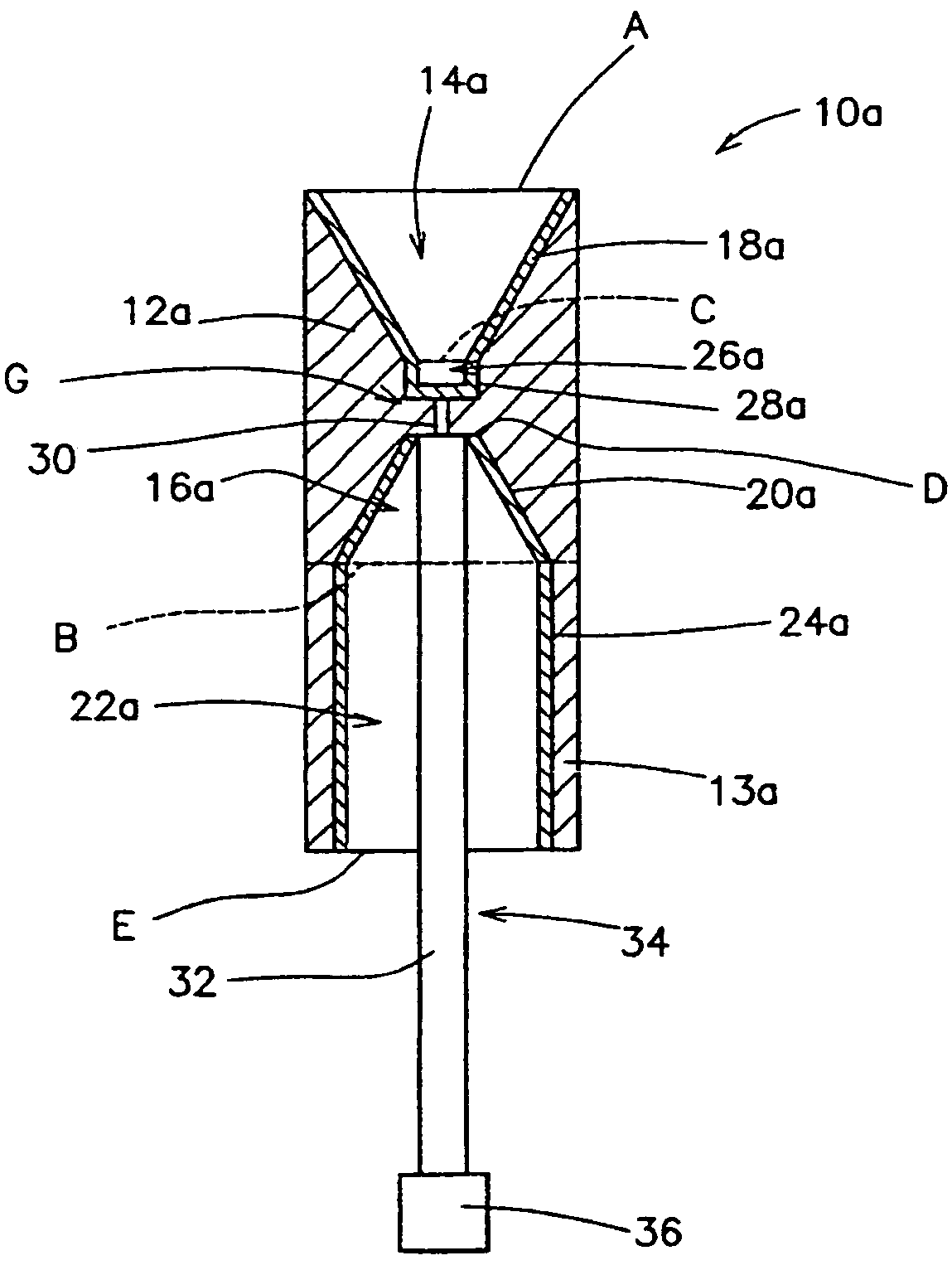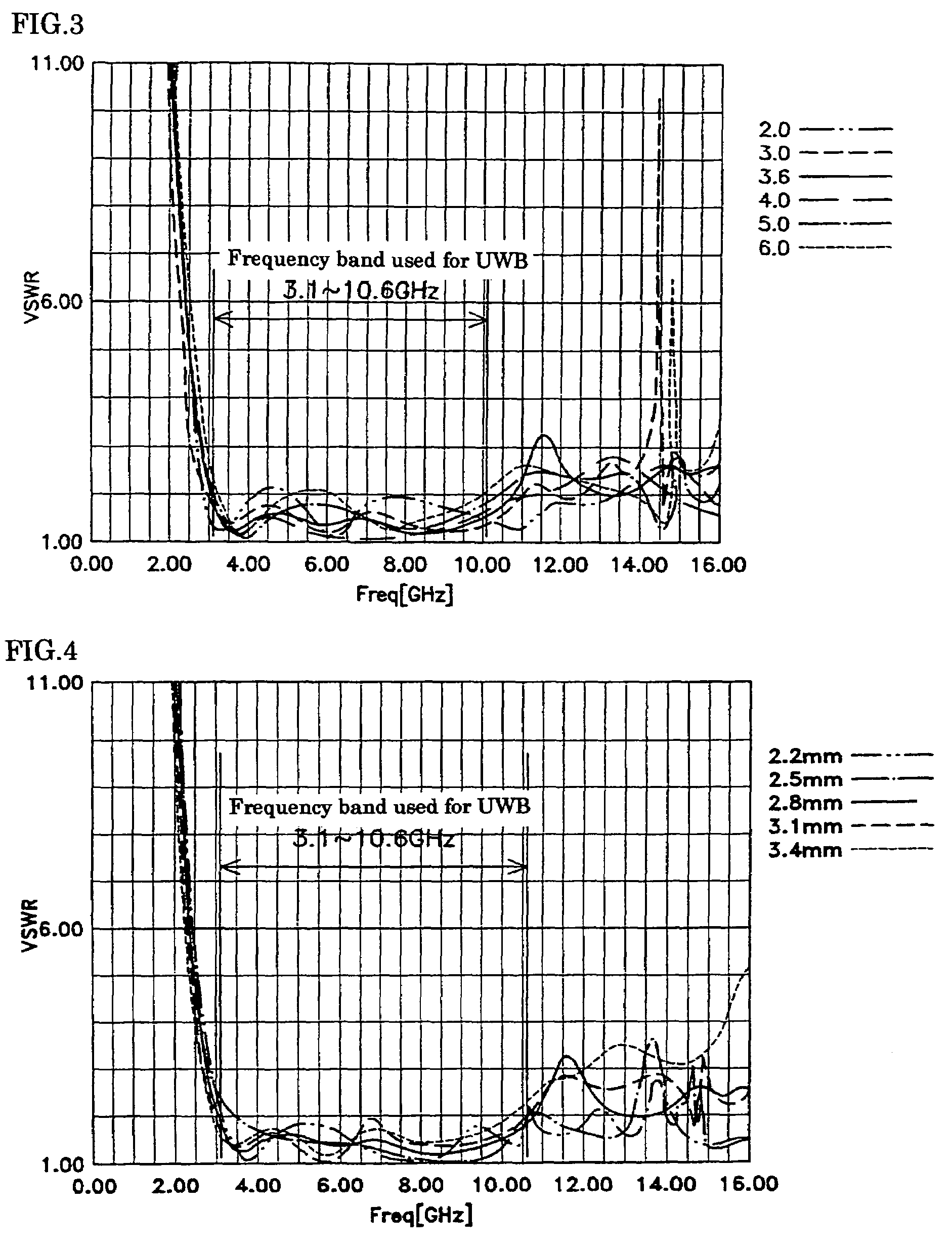Biconical antenna
a biconical antenna and antenna technology, applied in antennas, antenna feed intermediates, electrical devices, etc., can solve the problems of difficult to use the conventional biconical antenna, too large to attach to a notebook computer, and short distance over which communication is possible in uwb communication
- Summary
- Abstract
- Description
- Claims
- Application Information
AI Technical Summary
Benefits of technology
Problems solved by technology
Method used
Image
Examples
working example 1
[0101]Working Example 1 relates to the case that the feeder portion 112a and the ground portion 114a have the same frustum shape, as shown in FIG. 12. The feeder portion 112a and the ground portion 114a have the same frustum shape, and are arranged coaxially but oriented in opposite directions, with the gap 16a arranged between them, thus forming a symmetrical shape. The bottom portions B and B′ of the frustum shapes both have a diameter of 15 mm, and the diameters of the apex portions A and A′ are both 2.4 mm, and their heights are both 13 mm. The apex portions A and A′ of the feeder portion 112a and the ground portion 114a are parallel to one another. The gap 106a is 1.5 mm. The relative permittivity of the dielectric member 118 is 3.6.
[0102]The following is a discussion of the simulation results for the biconical antenna shown in FIG. 12.
[0103]FIG. 13 is a graph showing the simulation result for Working Example 1 of a biconical antenna according to the second embodiment. In this ...
working example 2
[0117]Working Example 2 relates to the case that the shapes of the feeder portion 112b and the ground portion 114b are different.
[0118]FIG. 19 is a diagram showing the configuration of a biconical antenna in which the height of the feeder portion 112b is different from the height of the ground portion 114b. The height of the frustum-shaped feeder portion 112b is higher than the height of the frustum-shaped ground portion 114b. Moreover, the apex portion A of the feeder portion 112b is provided with a reflector 130b. The reflector 130b is disk-shaped. This reflector 130b has the function of smoothly cutting high-frequency components. It should be noted that a configuration without the reflector 130b is also possible. Furthermore, there is a ground reinforcement portion 128b that is connected to the bottom portion B′ of the ground portion 114b. The diameter of the bottom portion B′ of the ground portion 114b is the same as the diameter of the ground reinforcement portion 128b, for exa...
working example 3
[0131]Working Example 3 is based on the biconical antenna 110a of Working Example 1, and is provided with a reflector 130c.
[0132]FIG. 29 is a diagram showing the configuration of an antenna in which the biconical antenna 110a of Working Example 1 is provided with a reflector 130c. The reflector 130c is provided at the apex of the feeder portion 112c. The reflector 130c is disk-shaped. The height of the reflector 130c is 1 mm.
[0133]FIG. 30 is a graph showing the VSWR simulation results when varying the diameter C of the reflector 130c. From this graph, it can be seen that a band-stop filter can be configured by providing the reflector 130c. Thus, the effect is achieved that if the desired frequencies can be cut by the reflector 130c, it is not necessary anymore to provide the antenna 110c with a separate band-stop filter.
PUM
 Login to View More
Login to View More Abstract
Description
Claims
Application Information
 Login to View More
Login to View More - R&D
- Intellectual Property
- Life Sciences
- Materials
- Tech Scout
- Unparalleled Data Quality
- Higher Quality Content
- 60% Fewer Hallucinations
Browse by: Latest US Patents, China's latest patents, Technical Efficacy Thesaurus, Application Domain, Technology Topic, Popular Technical Reports.
© 2025 PatSnap. All rights reserved.Legal|Privacy policy|Modern Slavery Act Transparency Statement|Sitemap|About US| Contact US: help@patsnap.com



